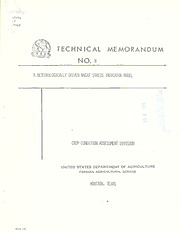
A meteorologically driven wheat stress indicator model PDF
Preview A meteorologically driven wheat stress indicator model
Historic, Archive Document Do not assume content reflects current scientific knowledge, policies, or practices. aS494 .5 •E8A8 TECHNICAL MEMORANDUM NO. 8 A METEOROLOGICALLY DRIVEN WHEAT STRESS INDICATOR LDDEL UNITED STATES DEPARTMENT OF AGRICULTURE FOREIGN AGRICULTURAL SERVICE HOUSTON, TEXAS NASA-JSC •> . UNITED STATES DEPARTMENT OF AGRICULTURE FOREIGN AGRICULTURAL SERVICE A METEOROLOGICALLY DRIVEN WHEAT STRESS INDICATOR MODEL FIRST ISSUE Document the development of a model capable of giving an early indication of actual or potential plant stress due to rroisture and temperature. 2. COVERAGE The moisture/ temperature values which both stress and optimize the vigor of the wheat plant by specific growth stages are re- viewed. A description of the model structure and stress para- meters are set forth. Model output and preliminary results are di scussed. 3. PREPARED BY 4 ACKNOWLEDGEMENT P. Ashburn for his briefings on USSR agriculture and locating research documentation vital to this model. E. Bui loch for providing background on soil water holding capacities. Their contributions are hereby gratefully acknowledged. JUL 2 1979 table of acNTENrs Page No. PART 1.0 INTRODUCTION 1.1 Purpose 1-1 1.2 Situation 1-1 1.3 Background 1-1 1.4 References 1-2 PART 2.0 FUNCTIONS OF MOISTURE STRESS 2.1 Major Variables 2-1 2.2 Phrenological Growth Stages 2-1 2.3 Stress Conditions by Growth Stage 2-1 FIGURE - 1 EMI'S and Phenological Growth Stages 2-2 TABLE - 1 Problon and Optimal Conditions that 2-3 Form Model Logic by Growth Stage PART 3.0 WHEAT STRESS INDICATOR tvDDEL 3.1 Model Components 3-1 3.2 Structure of the Model 3-1 3.3 Model Parameters 3-1 3.4 Test Results 3-2 PART 4.0 CONCLUSIONS 4.1 Surrmary 4-1 JUL 2 1979 TC-l £ 1 PART 1.0 TM-8 PAR. 1 . METEOROLOGICALLY DRIVEN WIEAT STRESS INDICATOR MDDEL PART 1 .0 INTRODUCTION 1.1 PURPOSE The purpose of this Technical Memorandum is to document a wheat condi- tion model that detects plant stress due to moisture deficiency and adverse temperatures and gives information on potential impact. A brief synposis of the climatic stress process on wheat at different growth stages is also given. 1.2 SITUATION A major task of the Crop Condition Assessment Division, Foreign Agricul- tural Service, is to detect and assess adverse conditions that affect a crop's growth and production. Of major importance is moisture stress that occurs in wheat. To support this activity a moisture and temperature stress model was developed to alert a crop analyst of a potential problem area. The model utilizes meteorological data because it is generally available much sooner than Landsat data, and provides daily data versus the eighteen day interval data from Landsat. This model eliminates the necessity of spending time and resources in analyzing data over all wheat areas and allows these resources to concentrate on areas which the model indicates have high probability that stress is occurring or is likely to occur. After a potential stress area has been identified, an analyst can assess the condition using meteorological, Landsat, and ancillary data. This model is not intended as a stand-alone system, but rather, an indicator to a crop analyst to initiate an investigation of the area. The OCAD mission of alert analysis requires a quick response system and will sacrifice exact quantative results to meet their response require- ment. A subjective estimate, if timely, which provides information in general terms such as better or worse than last year and an approximate percentage is very useful in assessing an alert situation. As research provides better tools, it is believed that these subjective estimates can be made quantitatively accurate. 1 .3 BACKOIOUND Wheat, during its growth cycle, can be subjected to many adverse factors by nature which will affect the yield, quality and may even destroy the plant. Some of these factors can be detected by use of meteorological hazard models. A good example of such models are yield models and wdnter- ki 1 1 models (TM No. 5 - A Meteorological Model to Aid in the Detection of Winterkill, January 24, 1979) which indicates potential destruction of the plant. The OCAD of FAS requires information on the condition of wheat, both winter and spring varieties, over various parts of the world. This evaluation of wheat production is not necessarily quantative, but more of a subjective nature. Inventories that generate a quantative estimate of production in bushels per acre over large areas are extremely expensive and slow in response. Page 1-1 iUL 2 1979 /
